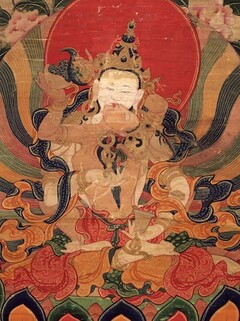Vajrasattva Visualisation and Recitation
༄༅། །རྡོར་སེམས་སྒོམ་བཟླས་མདོར་བསྡུས།
Brief Vajrasattva Visualisation and Mantra Recitation
by Jamyang Khyentse Chökyi Lodrö
རྡོར་སེམས་སྒོམ་བཟླས་མདོར་བསྡུས་པར་འདོད་ན། །
Should you wish to practice a brief visualisation and mantra recitation for Vajrasattva, recite the following:
སངས་རྒྱས་ཆོས་དང་ཚོགས་ཀྱི་མཆོག་རྣམས་ལ། །
sangye chö dang tsok kyi chok nam la
In the Buddha, the Dharma and the Supreme Assembly
བྱང་ཆུབ་བར་དུ་བདག་ནི་སྐྱབས་སུ་མཆི། །
changchub bardu dak ni kyab su chi
I take refuge until I attain enlightenment.
བདག་གིས་སྦྱིན་སོགས་བགྱིས་པའི་བསོད་ནམས་ཀྱིས། །
dak gi jin sok gyipé sönam kyi
Through the merit of practising generosity and so on,
འགྲོ་ལ་ཕན་ཕྱིར་སངས་རྒྱས་འགྲུབ་པར་ཤོག །
dro la pen chir sangye drubpar shok
May I attain buddhahood for the benefit of all beings.
ཞེས་སྐྱབས་སེམས་ལན་གསུམ་སྔོན་དུ་འགྲོ་བས། །
Repeat this verse of refuge and bodhicitta three times as a preliminary, then continue with:
རང་ཉིད་ཐ་མལ་གནས་པ་ཡི། །
rangnyi tamal nepa yi
I am in my ordinary form.
སྤྱི་བོ་པད་དཀར་ཟླ་བའི་སྟེང་། །
chiwo pekar dawé teng
Above my head, on a white lotus and moon,
བླ་མ་རྡོ་རྗེ་སེམས་དཔའ་ནི། །
lama dorjé sempa ni
Is the guru Vajrasattva,
དཀར་གསལ་རྡོ་རྗེ་དྲིལ་བུ་བསྣམས། །
karsal dorjé drilbu nam
Brilliant white and holding vajra and bell.
རང་འོད་སྙེམ་མ་དཀར་མོ་ནི། །
rang ö nyem ma karmo ni
Amidst his own radiance, he embraces white Vajragarvā,1
གྲི་གུག་ཐོད་པ་འཛིན་པས་འཁྱུད། །
driguk töpa dzinpé khyü
Who holds a hooked knife and skullcup.
རྡོ་རྗེ་པདྨའི་སྐྱིལ་ཀྲུང་བཞུགས། །
dorjé pemé kyiltrung zhuk
They are seated in vajra and lotus postures
དར་དང་རིན་ཆེན་རྒྱན་གྱིས་བརྒྱན། །
dar dang rinchen gyen gyi gyen
And wear silk and jewel ornaments.
ཐུགས་ཀར་ཟླ་སྟེང་ཧཱུྃ་གི་མཐར། །
tukkar da teng hung gi tar
At Vajrasattva’s heart, upon a moon disc is Hūṃ,
ཡི་གེ་བརྒྱ་པས་བསྐོར་བར་གྱུར། །
yigé gyapé korwar gyur
Encircled by the hundred-syllable mantra.
བདག་སོགས་སེམས་ཅན་ཐམས་ཅད་ཀྱི། །
dak sok semchen tamché kyi
For me and all other sentient beings,
སྡིག་སྒྲིབ་ཉེས་ལྟུང་དམ་སྡོམ་ཉམས། །
dikdrib nyetung dam dom nyam
Let all our misdeeds, obscurations, downfalls and impairments of vows and commitments,
མ་ལུས་བྱང་བར་མཛད་དུ་གསོལ། །
malü jangwar dzé du sol
Be purified, each and every one, I pray.
སྐུ་ལས་བདུད་རྩིའི་རྒྱུན་བབས་པས། །
ku lé dütsi gyün babpé
From his body flows a stream of nectar
ནད་གདོན་སྡིག་ལྟུང་དམ་གྲིབ་རྣམས། །
nedön diktung dam drib nam
That removes illnesses, harmful influences, misdeeds, downfalls, and samaya pollution,
དུད་སོལ་ཁུ་རླངས་རྣག་ཁྲག་དང་། །
dü solkhu lang naktrak dang
Expelling them in the form of smoke, soot, steam, pus, blood,
སྲོག་ཆག་རྣམ་པས་ཕྱིར་དོན་ཏེ། །
sok chak nampé chir dön té
And tiny creatures.
ལུས་ནང་བདུད་རྩིའི་ཁེངས་པར་གྱུར། །
lü nang dütsi khengpar gyur
The nectar then fills the whole interior of the body.
ཞེས་བརྗོད་ལ།
Recite:
ཨོཾ་བཛྲ་སཏྭ་ས་མ་ཡ། མ་ནུ་པཱ་ལ་ཡ། བཛྲ་སཏྭ་ཏྭེ་ནོ་པ་ཏིཥྛ། དྲྀ་ཌྷོ་མེ་བྷ་ཝ། སུ་ཏོཥྱོ་མེ་བྷ་ཝ། སུ་པོཥྱོ་མེ་བྷ་ཝ། ཨ་ནུ་རཀྟོ་མེ་བྷ་ཝ། སརྦ་སིདྡྷི་མྨེ་པྲ་ཡཙྪ། སརྦ་ཀརྨ་སུ་ཙ་མེ། ཙིཏྟཾ་ཤྲེ་ཡཿཀུ་རུ་ཧཱུྃ། ཧ་ཧ་ཧ་ཧ་ཧོཿབྷ་ག་ཝཱན། སརྦ་ཏ་ཐཱ་ག་ཏ། བཛྲ་མཱ་མེ་མུཉྩ། བཛྲཱ་བྷ་ཝ། མ་ཧཱ་ས་མ་ཡ་སཏྭ་ཨཱཿ ཧཱུྃ་ཕཊ།
om benza sato samaya manu palaya benza sato té nopa tishta dridho mé bhava sutokhayo mé bhava supokhayo mé bhava anurakto mé bhava sarva siddhi mé prayatsa sarva karma sutsa mé tsittam shré yah kuru hung ha ha ha ha ho bhagavan sarva tathagata benza ma mé muntsa badzra bhava maha samayasato ah hung pé
oṃ vajrasattva samayam anupālaya vajrasattva-tvenopa-tiṣṭha dṛḍho me bhava sutoṣyo me bhava supoṣyo me bhava anurakto me bhava sarva-siddhiṃ me prayaccha sarva-karma śuca me cittaṃ śreyaṅ-kuru hūṃ ha ha ha ha hoḥ bhagavān sarva-tathāgata-vajra mā me muñca vajrī-bhava mahā-samaya-sattva āḥ hūṃ phaṭ
ཞེས་ཡིག་བརྒྱ་ཅི་ནུས་དང་། ཡང་སྙིང་།
Repeat this hundred-syllable mantra as many times as possible. Then continue with its quintessence:
ཨོཾ་བཛྲ་སཏྭ་ཨཱཿ
om benza sato ah
oṃ vajrasattva āḥ
ཞེས་ཅི་ནུས་བཟླས་མཐར།
Recite this too as many times as possible. At the end continue with:
མགོན་པོ་བདག་ནི་མི་ཤེས་རྨོངས་པ་ཡི། །
gönpo dak ni mi shé mongpa yi
O protector! In my ignorance and delusion
དམ་ཚིག་ལས་ནི་འགལ་ཞིང་ཉམས། །
damtsik lé ni gal zhing nyam
I have gone against and corrupted my samaya.
བླ་མ་མགོན་པོས་སྐྱངས་མཛོད་ཅིག །
lama gönpö kyang dzö chik
Lama protector, be my refuge!
གཙོ་བོ་རྡོ་རྗེ་འཛིན་པ་སྟེ། །
tsowo dorjé dzinpa té
Chief of all the maṇḍalas, vajra holder,
ཐུགས་རྗེ་ཆེན་པོའི་བདག་ཉིད་ཅན། །
tukjé chenpö daknyi chen
Embodiment of great compassion:
འགྲོ་བའི་གཙོ་ལ་བདག་སྐྱབས་མཆི། །
drowé tso la dak kyab chi
Chief of all living beings, in you I take refuge!2
སྐུ་གསུང་ཐུགས་རྩ་བ་དང་ཡན་ལག་གི་དམ་ཚིག་ཉམས་པ་ཐམས་ཅད་མཐོལ་ལོ་བཤགས་སོ། །
ku sung tuk tsawa dang yenlak gi damtsik nyampa tamché tol lo shak so
I confess all my impairments of the root and branch samayas of the body, speech and mind.
སྡིག་སྒྲིབ་ཉེས་ལྟུང་དྲི་མའི་ཚོགས་ཐམས་ཅད་བྱང་ཞིང་དག་པར་མཛད་དུ་གསོལ།
dikdrib nyetung drimé tsok tamché jang zhing dakpar dzé du sol
I implore you: let my negative actions, obscurations, wrongdoing and downfalls—all my flaws—be completely cleansed and purified!
བླ་མ་དགྱེས་པས་དག་ཚངས་བྱིན། །
lama gyepé dak tsang jin
The guru is pleased and grants purification.
འོད་ཞུ་རང་ལ་ཐིམ་པར་གྱུར། །
ö zhu rang la timpar gyur
He melts into light and dissolves into me.
ཅེས་བརྗོད་ལ།
Then:
དགེ་བ་འདི་ཡིས་མྱུར་དུ་བདག །
gewa di yi nyurdu dak
Through the positivity and merit of this, may I swiftly
རྡོ་རྗེ་སེམས་དཔའ་འགྲུབ་གྱུར་ནས། །
dorjé sempa drub gyur né
Attain the realization of Vajrasattva, and thereby
འགྲོ་བ་གཅིག་ཀྱང་མ་ལུས་པ། །
drowa chik kyang malüpa
Every single sentient being
དེ་ཡི་ས་ལ་འགོད་པར་ཤོག །
dé yi sa la göpar shok
Reach his state of perfection too.
ཅེས་སོགས་ཀྱི་དགེ་བསྔོ་བྱའོ། །
With this, dedicate the virtue.
ཅེས་པའང་ཆོས་ཀྱི་བློ་གྲོས་པས་བྲིས་པའོ།། །།
Written by Chökyi Lodrö.
| Translated by Adam Pearcey with the generous support of the Khyentse Foundation and Tertön Sogyal Trust, 2020.
Source:
'Jam dbyangs chos kyi blo gros. "rdor sems rgyun 'khyer ye shes chu rgyun/" in ’Jam dbyangs chos kyi blo gros kyi gsung ’bum. 12 vols. Bir: Khyentse Labrang, 2012. W1KG12986 Vol. 6: 306–308
Version: 1.1-20230317
- ↑ Although Vajrāṭopā is sometimes given as the Sanskrit name of Vajrasattva's consort, whose Tibetan name is Dorje Nyemma (rdo rje snyems ma), it seems that the correct Sanskrit name, which is attested in several extant sources, is Vajragarvā.
- ↑ This famous verse, beginning with ‘In my ignorance and delusion...’ is frequently recited during confession practices. Its source is the Abhidhānottaratantra, The Appendix to the Discourse Tantra (D 369, mngon brjod rgyud bla ma). The Abhidhāna is an ‘appendix’ to the Laghuśaṃvara, The Smaller Śaṃvara (D 368, bde mchog nyung ngu), the root tantra of Cakrasaṃvara.
